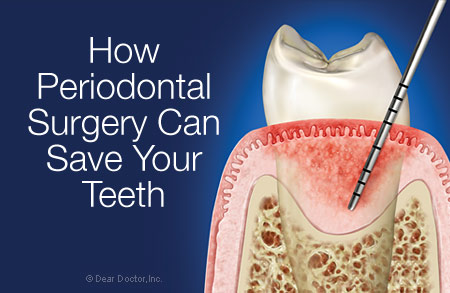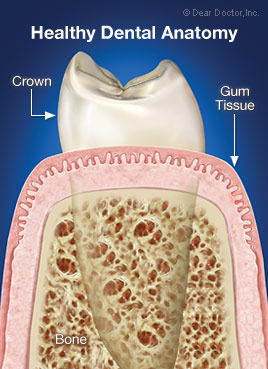Periodontal Flap Surgery
How Periodontal Surgery Can Save Your Teeth

Periodontal flap surgery describes the state of-the-art techniques and most commonly used approach to the surgical treatment and plastic surgical repair of periodontal pockets. “Pocketing” is the end result of inflammation and infection that causes the loss of tissue attachment to the teeth, one common consequence of periodontal (gum) disease.
Treatment is based on an understanding of the disease process, the interaction between the bacterial biofilm or plaque collections at the gum line and the immune (resistance) system in a person susceptible to (likely to get) this disease. The long-term goal of periodontal surgery is to help increase the life expectancy of the teeth.
It is not a cure, but rather creates an environment that makes it easier to maintain health. Treatment is therefore aimed at controlling the basic cause — the bacterial biofilm — over a lifetime. Vigilance in home care and regular periodontal recall cleanings and monitoring are necessary to ensure success.

Periodontal Surgery In Perspective
The purpose of periodontal surgery is to treat deformities and tissue loss created by the disease process, eliminating “pockets” of diseased tissue in order to create and maintain periodontal health. Techniques have been developed to deal with the gingival (gum) tissues and underlying bone. The objectives of periodontal flap surgery are to:
- Eliminate or reduce pockets.
- Regenerate periodontal tissues and their (re)-attachment to the teeth.
- Create more normal periodontal form, function, and aesthetics;
- Promote an environment more conducive to good oral hygiene practices and professional maintenance care.
Flap Surgery — A Conservative Yet Versatile Approach
Current surgical flap techniques are based on a sound understanding of wound healing and are therefore designed to enhance and maximize the body's healing potential. Flap surgery is the most conservative and versatile way to treat periodontal pocketing. An internal surgical opening is used to access the affected gum tissues to create and raise a “flap” of gum tissue, similar to opening the flap of an envelope, aimed at the conservation of all healthy tissue. This approach allows:
- Removal of inner diseased tissue lining the pockets. (This tissue is ulcerated, resulting in open sores within the gum tissues, which are chronically inflamed.)
- Access to treat and clean root surfaces completely.
- Regeneration of lost bone and periodontal ligament.
- Intimate closure of the healthy tissues leaving no open wounds for rapid and comfortable healing.




